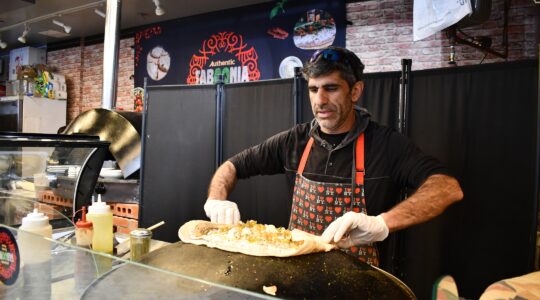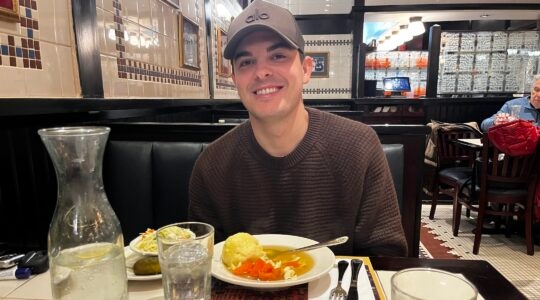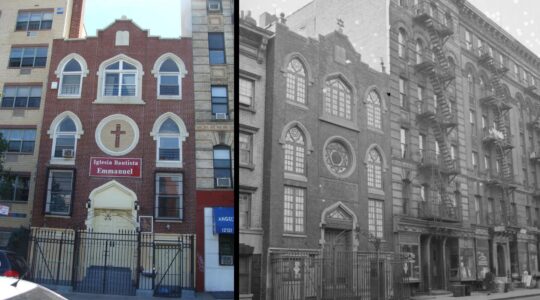NEW YORK — “You wanna hear a B&H story? I’ll tell you a B&H story.”
This was a woman paying her check and about to leave the tiny dairy restaurant in Manhattan’s East Village. She overheard me asking the guy buying me lunch, a fella named Andy, to tell me a little bit about the place. He’s the unofficial spokesman for this extremely familial noshery. But before he could get into why the 80-year-old B&H was so special, we got interrupted.
“So I’ll tell you!” the woman continued, somewhat unprompted. “I was down in Florida with my mother. 90 years old! We were at the pool where she lives, and we were talking about how much we love B&H. The old woman next to us says ‘I used to live there, my family owned it!’”
“Oh, that must have been Florence,” replied Andy, who has pieced together the provenance of ownership from 1938 until now.
“I don’t remember,” the woman said. “But I just brought two handsome Jewish French 20 year olds here for brunch. I met them in Central Park, and I showed them pictures of my nieces and we’re all invited to France now. I should go!”
The woman pays her bill, shouts good-bye to the cook in the back and leaves.
Okay, so now Andy and I can get back to talking. To start talking, really.
“Hi Becky, you been shopping?” a counterman calls out as a Jewish 20-something comes in with bags from Macy’s. She laughs and orders her regular. The place is so small that I can’t help but be part of that conversation, too.
“What’s the regular?” I ask, and she tells me a grilled cheese on challah with over-easy eggs inside. She tells me she’s been coming here nonstop since she was 12. “Where did you go before?”
“The Upper West Side,” she shrugs.
B&H is named for its original owners, Bergson and Heller, which quickly became Bergson and Hausman. Luckily, they didn’t need to change the name.
The place is a time capsule, and I don’t mean that it is a retro-kitschy way. I mean it has the same no-frills décor of a minuscule restaurant focused on serving great, old-fashioned Eastern European Jewish food. You can look at old photographs and see some of the same refrigeration units. They built stuff to last back then.
It’s one of the few remaining kosher restaurants in a neighborhood with a not-particularly-Orthodox population. It dates back to when this stretch of 2nd Avenue was called The Jewish Rialto, the hub of Yiddish theater. In the late 1960s, when the Fillmore East rock venue was just a few steps away, one could grab a quick blintz before seeing The Grateful Dead or Janis Joplin. (The legendary concert venue is a bank now.) In the late 1970s, punk rock mecca CBGB’s was just around the corner. Now the area is dealing with the ascendancy of New York University and gentrification.
Somehow, B&H remains weird and friendly. I can’t remember the last time I sat in a New York restaurant and everyone seemed to know one another’s name.
I get some food. First, some matzo ball soup. I couldn’t decide between that or split pea or borscht. No bad choices. It’s not too salty and it doesn’t skimp on the dill. There’s no chicken in it (it’s a dairy restaurant) but it doesn’t need it. It’s fantastic.
Also, challah. Rich, but airy. And pre-buttered. Why does it taste so much better when someone else puts the butter on it?
Okay, so we’re getting to the big punchline. No one working at B&H is Jewish.
The owners are the Abdelwaheds — Ola, a Polish immigrant, and Fawzy, her husband, an Egyptian immigrant. Most of the cooks are Latin, though the woman on soup duty is Polish and there are some other Egyptians in the mix, too.
The T-shirts that Andy made for the restaurant read “Challah, Por Favor.” (Andy, who doesn’t technically work there, but lives down the block and just loves the place, is originally from the very Jewish Shaker Heights neighborhood in Cleveland, Ohio — and, he laughs, “technically not Jewish.”)
“I help out because I love the place,” he says. It certainly has romantic appeal. “And people who work here stay. Leo in the back has been here 29 years. It’s 29, right Leo?” Leo doesn’t respond. “Sometimes Leo speaks English. Not today,” Andy shrugs.
Next up are some cheese blintzes. Light and sweet. Probably the best I’ve had since my grandmother passed away. I’m trying to keep my cool, but I’m flipping out inside.
Ola can tell I’m enjoying them. She’s definitely someone who takes joy in serving people. She’s about to leave for the day and she’s taking a delivery with her: “I’m stopping down by City Hall, to an old Jewish lady, before I head home to Queens.”
They currently don’t deliver, which is unheard of in Manhattan, but there have been some issues lately. Ola rolls her eyes. “We had one guy, but he had a bad foot. We had another guy who drinks. Then the one who could never find the addresses.”
Ola’s journey to serving me blintzes is a strange one. She was working at the Stage Diner (since closed) which was on the same block as B&H. An Egyptian immigrant who ran a falafel stand would come in all the time, and he would put his eyeglasses on the table. She could see they were filthy, so one time she picked them up and wiped them with a rag. They fell in love, married and, in 2003, they bought this place.
There was trouble in 2015 when a gas explosion nearby forced the restaurant to shut down for months. A crowdfunding project (aided by Andy, naturally) kept the place alive.
Now we’re on to potato pancakes and Dr. Brown’s Cel-Ray soda. Find me a better duo! Again, not too salty, but crispy and perfect. There’s some sour cream on the side but these taste perfect on their own.
I’m not the only one who has enjoyed this food. Andy shows me a photo of a scrap of paper handed down to him from one of the old countermen. Famous diners included Shelley Winters, Jack Klugman, Jimi Hendrix, Molly Picon and “the lady that won the Nobel Peace Prize, Dr. Yallow,” who apparently ate vegetarian liver sandwiches. (Dr. Yalow, with only one “l,” actually won for Physiology and Medicine, but let’s not bicker.)
B&H sticking to dairy only is part of the reason why they don’t keep super late hours for what’s otherwise a never-sleep neighborhood. “The kids coming from the clubs want meat,” Ola tells me. “They come here with a blintz and ‘zzzzzz,’” she jokes, putting her head down on the counter.
Andy can’t tell me exactly when the 80th anniversary is. “Some time soon. When the weather is good.” As we start wrapping up a man named Manny who “does the books” comes in with his pregnant daughter. Not to eat, just to say hi. There are a lot of hugs and offers of congratulations. So we don’t know the exact day of the anniversary, but it’s clear that every day is a party.
The New York Jewish Week brings you the stories behind the headlines, keeping you connected to Jewish life in New York. Help sustain the reporting you trust by donating today.




